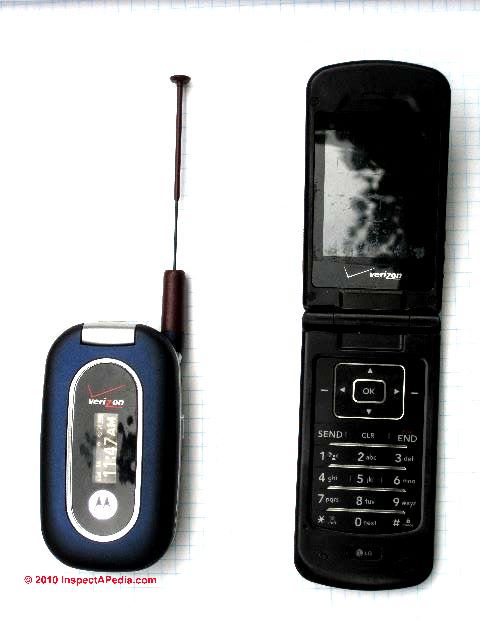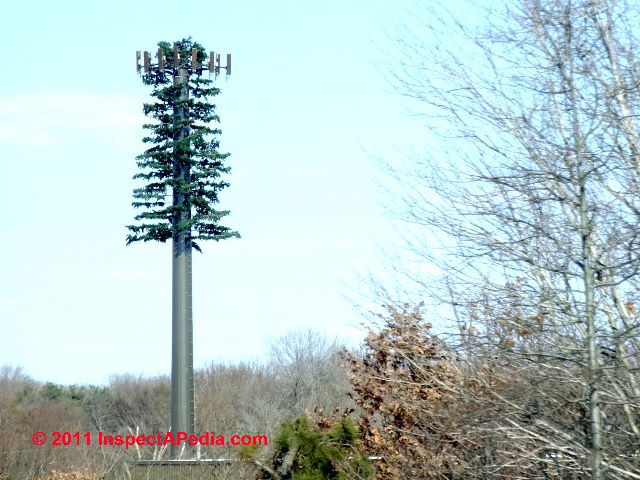 Cellphone Radiation Hazard Information & Hazard Reduction
Cellphone Radiation Hazard Information & Hazard Reduction
- POST a QUESTION or COMMENT about cellphone radiation exposure levels & mesurement methods
This article discusses consumer concerns about cell-phone radiation or electromagnetic field (EMF) or electro-magnetic radiation EMR and related terms such as EMF, radio frequency - RF, hertz or cycles, megahertz, medium frequency MF, very high frequency VHF, ultra high frequency UHF, megahertz MHz, gigahertz GHz, terahertz THz .
We include cell phone radiation exposure standards and suggestions from various sources on how to reduce cell phone radiation exposure
InspectAPedia tolerates no conflicts of interest. We have no relationship with advertisers, products, or services discussed at this website.
- Daniel Friedman, Publisher/Editor/Author - See WHO ARE WE?
Cellphone Radiation Information & Reducing Cellphone EMR Exposure
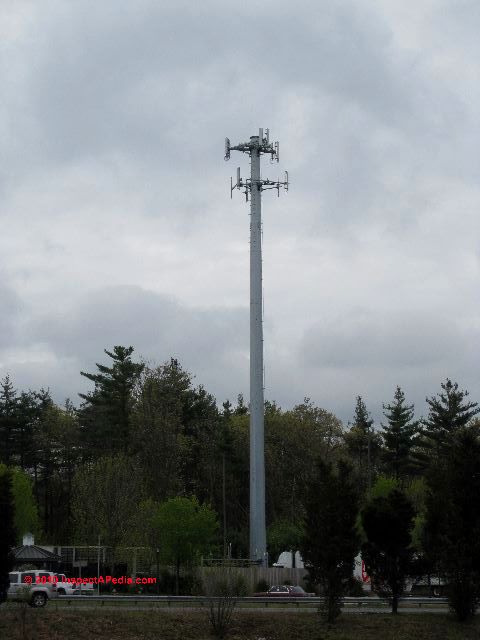
Our page top photo of a cell phone signal tower whose appearance was improved to resemble a steel tree was taken along the New Jersey Turnpike.
Scientific research on possible health hazards from cellphone use to date (2010) has produced inconclusive and conflicting results, varying by study. According to an article in June 2010 the New York Times,
Both the National Cancer Institute and the F.C.C. [Federal Communications Commission] say that there is no scientific evidence that wireless phones are dangerous, but each agency continues to monitor continuing medical studies.
A widely cited January 2006 Swedish study (Kjell Mild) of both cordless home telephone use and cell phone use by children and teenagers found that that population were more likely to suffer brain cancer if they used mobile telephones.
The U.S. FDA has questioned the reliability of the study, including pointing out that the study had not reported on the mechanism of action that caused the brain cancers cited.
Professor Lennart Hardell (University Hospital, Orebro, Sweden) who led the study reported at a September 2008 conference hosted at the Royal Society by the Radiation Research Trust "people who started mobile phone use before the age of 20" had more than five-fold increase in glioma", a cancer of the glial cells that support the central nervous system.
The extra risk to young people of contracting the disease from using the cordless phone found in many homes was almost as great, at more than four times higher.
The cell phone tower in our photo (above left) is located in Westchester County, New York. Exposure of electromagnetic radiation from cell towers is normally a separate question from EMR exposure from use of cellphones themselves.
So can using a cell phone increase the risk of brain tumors or not?
The answer is a definite ... maybe.
Attempts to sort through the confusion of multiple studies of possible cancer risks associated with cell phones have been made with some success.
See "Mobile Phone Use and Risk of Tumors: A Meta-Analysis", Seung-Kwon Myung et als, 2009.
This meta study of 465 articles from MEDLINE, EMBASE, and the Cochrane Library (Aug. 2008) concluded that
The current study found that there is possible evidence linking mobile phone use to an increased risk of tumors from a meta-analysis of low-biased case-control studies.
Prospective cohort studies providing a higher level of evidence are needed.
Definition of cellphone radiation - cellular telephones, because they include a radio transmitter, emit electromagnetic fields (EMF, or EMR).
In the United States the Federal Communications Commission (FCC) specifies the allowable limits of cell phone radiation.
If ultimately cell phone radiation is shown to be a health risk to some users, a possible concern is the exposure of the human ear and brain to cellphone radiation, especially as newer digital cell phones operate at higher power and at frequencies in the 1800-2000 MHz range.
Presently some cell phones may exceed the FCC EMR or SAR (defined below) limit that was set when most cell phones were analog in signal design and emitted lower-strength EMFs in the 800-900 MHz range.
Definition of SAR & SAR Limits
Specific Absorption Rate of Radiation - measures the amount of radiation that a human body absorbs from a source such as from a nearby radio transmitting antenna or cellphone (radio receiving antennas do not emit EMF).
What type of radiation is emitted by a cellphone?
Older cell phones emit and receive low level radio frequency waves from 200 MHz to more than 800 MHz. Newer cell phones operate in the wider 900 MHz to 2.4 GHz or more (approaching the power and frequency of microwaves and infrared waves).
How much radiation is emitted by a cellphone?
The answer depends on the cell phone technology (cell phone model, analog versus digital signal), the cell phone transmitter strength (newer phones may be more powerful), and other factors. Cell phone radiation, measured in watts per kilogram of body tissue, ranges from 0.2 watts/Kg to 1.6 watts/Kg.
[We have read articles claiming that some phone models exceed the current legal limit of 1.6 w/Kg. - citation needed].
Cellphone Model Radiation Rate Data:
independent test labs publish measurements of the levels of radiation emitted by specific cellphone models.
In June 2010 the New York Times reported on a San Francisco law that will require cellphone manufacturers to list the radiation rate of each cellphone model sold in that state. Retailers will be required to post the SAR (specific absorption rate) for each cellphone model.
What is SAR - Specific Absorption Rate?
The level of human exposure to cell phone radiation, which is not necessarily the same as the cell phone radiation rate, is measured in SAR, Specific Absorption Rate - the rate at which radio frequency energy (RF energy) is absorbed into human body tissues.
The Specific Absorption Rate (SAR) during cell phones in use depends on the distance the cellphone is held from the human head (further away is safer), and the distance to the nearest cell phone tower. While most of the human head is protected by bone, the ear is an area of soft tissue into the skull that might be an area of greater risk of injury by EMF from cellphone use.
Cell Phone Antennas vs. Cell Tower Antenna RF Exposure Hazard Differences
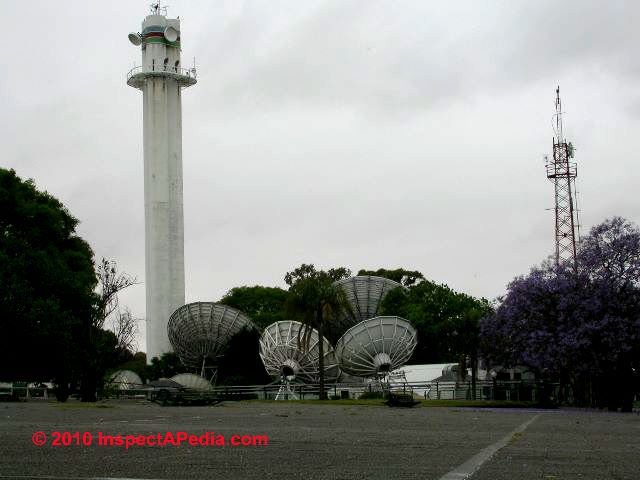 Don't confuse a cell tower antenna - the large usually outdoor antenna that receives and/or broadcasts cellphone frequencies to relay cell phone signals through the cell system - with the small, often hidden antenna within the cell phone itself (illustrated below
Don't confuse a cell tower antenna - the large usually outdoor antenna that receives and/or broadcasts cellphone frequencies to relay cell phone signals through the cell system - with the small, often hidden antenna within the cell phone itself (illustrated below
at SUGGESTIONS FOR REDUCING CELLPHONE RADIATION EXPOSURE).
Our photo (left) shows a collection of several types of radio transmit/receive antennas, including cell phone system signal relay towers, in Buenos Aires, Argentina.
Definition of EMF
an EMF or electromagnetic field is the field or area of force caused by movement of an electrical charge and containing some amount of electromagnetic energy.
Definition of EMR
Electromagnetic radiation, or electromagnetic radio frequency radiation EMFR. EMR or electromagnetic radiation is electrical and magnetic energy emitted by various types of energy sources: radio waves, microwaves, light, x-rays, and nuclear energy and sometimes expressed or measured in photons (particles) or as waves (discussed here).
EMR or EM radiation is the result of oscillating electrical and magnetic fields that move as an energy force in wave form through space.
Differences in RF Exposures from Cellphone Towers vs. Rooftop Cellphone Antennas
People on the ground are not likely to be exposed to RF energy levels that exceed typical government RF exposure standards (given below in this article). People living in building areas below a rooftop-mountp cell phone antenna might be exposed to higher RF strengths than those on the ground.
Radiofrequency emissions from antennas used for cellular and PCS [personal communications service] transmissions result in exposure levels on the ground that are typically thousands of times below safety limits.
These safety limits were adopted by the FCC based on the recommendations of expert organizations and endorsed by agencies of the Federal Government responsible for health and safety. Therefore, there is no reason to believe that such towers could constitute a potential health hazard to nearby residents or students.
- Source: Cellular Phone Towers, [Web article] American Cancer Society, retrieved 2017/12/26 original source: https://www.cancer.org/cancer/cancer-causes/radiation-exposure/cellular-phone-towers.html
Watch out: The risk of significant exposure to hazardous RF energy levels from a rooftop cell antenna may be significant and might exceed FCC guidelines for people are directly in front of an antenna or who are within a few meters of an antenna.
Inside a building, for example in an apartment located directly below a rooftop upon which a cell phone antenna is mounted, the exposure of building occupants to RF fields is likely to be significantly lower than if they were exposed at the same distance and position outdoors in open air.
That's because building materials block the transmission of RF field strength, typically to about 1/10 of the open-air strength of the same signal. (The actual RF signal blocking effect of building materials depends of course on the nature of the materials such as steel, concrete, or wood.)
The level of RF energy inside buildings where a base station is mounted is typically much lower than the level outside, depending on the construction materials of the building. Wood or cement block reduces the exposure level of RF radiation by a factor of about 10.
The energy level behind an antenna is hundreds to thousands of times lower than in front. Therefore, if an antenna is mounted on the side of a building, the exposure level in the room directly behind the wall is typically well below the recommended exposure limits. - Source: Cellular Phone Towers, [Web article] American Cancer Society, retrieved 2017/12/26 original source: https://www.cancer.org/cancer/cancer-causes/radiation-exposure/cellular-phone-towers.html
RF exposure limits for the U.S. and other countries are given at RESEARCH & STANDARDS ON CELL PHONE & CELL TOWER RADIATION SAFETY
US FDA Remarks on the Possible Health Hazards from Cell Phones
Quoting from the US FDA:
Do cell phones pose a health hazard?
Many people are concerned that cell phone radiation will cause cancer or other serious health hazards. The weight of scientific evidence has not linked cell phones with any health problems.
Cell phones emit low levels of radiofrequency energy (RF). Over the past 15 years, scientists have conducted hundreds of studies looking at the biological effects of the radiofrequency energy emitted by cell phones.
While some researchers have reported biological changes associated with RF energy, these studies have failed to be replicated. The majority of studies published have failed to show an association between exposure to radiofrequency from a cell phone and health problems.
The low levels of RF cell phones emit while in use are in the microwave frequency range. They also emit RF at substantially reduced time intervals when in the stand-by mode. Whereas high levels of RF can produce health effects (by heating tissue), exposure to low level RF that does not produce heating effects causes no known adverse health effects.
The biological effects of radiofrequency energy should not be confused with the effects from other types of electromagnetic energy.
Very high levels of electromagnetic energy, such as is found in X-rays and gamma rays can ionize biological tissues. Ionization is a process where electrons are stripped away from their normal locations in atoms and molecules. It can permanently damage biological tissues including DNA, the genetic material.
The energy levels associated with radiofrequency energy, including both radio waves and microwaves, are not great enough to cause the ionization of atoms and molecules. Therefore, RF energy is a type of non-ionizing radiation. Other types of non-ionizing radiation include visible light, infrared radiation (heat) and other forms of electromagnetic radiation with relatively low frequencies.
While RF energy doesn’t ionize particles, large amounts can increase body temperatures and cause tissue damage. Two areas of the body, the eyes and the testes, are particularly vulnerable to RF heating because there is relatively little blood flow in them to carry away excess heat.
Recent Epidemiological Reports on Cell Phone or Cell Phone Tower Hazards & Cancer Risks
Study Reports No Cell Phone Mast Exposure Link to Cancer
Study Reports No Child Hood Cancer Risk Connected to Mobile Phone Base Stations
Excerpts quoted from "Mobile phone base stations and early childhood cancers: case-control study" (Elliott 2010) cited in complete detail below.
Abstract
Objective To investigate the risk of early childhood cancers associated with the mother’s exposure to radiofrequency from and proximity to macrocell mobile phone base stations (masts) during pregnancy.
Design Case-control study.
Setting Cancer registry and national birth register data in Great Britain.
Participants 1397 cases of cancer in children aged 0-4 from national cancer registry 1999-2001 and 5588 birth controls from national birth register, individually matched by sex and date of birth (four controls per case).
Main outcome measures Incidence of cancers of the brain and central nervous system, leukaemia, and non-Hodgkin’s lymphomas, and all cancers combined, adjusted for small area measures of education level, socioeconomic deprivation, population density, and population mixing.
Results Mean distance of registered address at birth from a macrocell base station, based on a national database of 76 890 base station antennas in 1996-2001, was similar for cases and controls (1107 (SD 1131) m v 1073 (SD 1130) m, P=0.31), as was total power output of base stations within 700 m of the address (2.89 (SD 5.9) kW v 3.00 (SD 6.0) kW, P=0.54) and modelled power density (−30.3 (SD 21.7) dBm v −29.7 (SD 21.5) dBm, P=0.41).
For modelled power density at the address at birth, compared with the lowest exposure category the adjusted odds ratios were 1.01 (95% confidence interval 0.87 to 1.18) in the intermediate and 1.02 (0.88 to 1.20) in the highest exposure category for all cancers (P=0.79 for trend), 0.97 (0.69 to 1.37) and 0.76 (0.51 to 1.12), respectively, for brain and central nervous system cancers (P=0.33 for trend), and 1.16 (0.90 to 1.48) and 1.03 (0.79 to 1.34) for leukaemia and non-Hodgkin’s lymphoma (P=0.51 for trend).
Conclusions There is no association between risk of early childhood cancers and estimates of the mother’s exposure to mobile phone base stations during pregnancy.
Study Conclusions and policy implications
In summary, we found no association between risk of childhood cancers and mobile phone base station exposures during pregnancy.
The results of our study should help to place any future reports of cancer clusters near mobile phone base stations in a wider public health context.
What is already known on this topic
Previous reports of apparent cancer clusters near mobile phone base stations are difficult to interpret because of small numbers and possible selection and reporting biases There is no known radiobiological explanation for such cancer excesses
What this study adds
This study used national registers of cancers and births and available data on macrocell mobile phone base stations, thus avoiding selection and reporting biases There was no association between risk of early childhood cancers and estimates of exposure to mobile phone base stations during pregnancy
Source Citation
- Elliott P, Toledano MB, Bennett J, Beale L, de Hoogh K, Best N, Briggs DJ. Mobile phone base stations and early childhood cancers: case-control study [Website] British Medical Journal, 2010 Jun 22;340:c3077. doi: 10.1136/bmj.c3077. PMID: 20570865; PMCID: PMC3191724. copy on file as Elliot_BMJ_2010_Mobile_phone_base_stations_childhood cancers_ case-control study.pdf ]
- McKinley, Jesse, "San Francisco Law Will Make Cellphone Retailers List Radiation Rate", Jesse McKinley, The New York Times, 16 June 2010 p. A14.
- Reuters, Large study finds no cell phone mast link to cancer [Website] Reuters News, 6/22/2010, retreived 8/6/12, original source http://www.reuters.com/article/2010/06/22/us-cancer-cellphones
-masts-idUSTRE65L6L520100622 [copy on file as Elliott_Cell_Phone_Reuters.pdf]
Suggestions for Reducing Cellphone Radiation Exposure
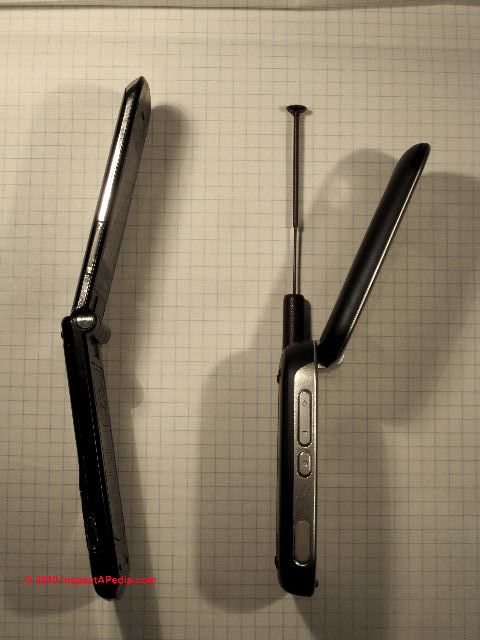 While the jury is out on health risks from cellphone use, those who agree that prudent avoidance is wise, even a cursory scan of the literature indicates that holding a cellphone further from the head (try using the speaker phone feature?) reduces exposure.
While the jury is out on health risks from cellphone use, those who agree that prudent avoidance is wise, even a cursory scan of the literature indicates that holding a cellphone further from the head (try using the speaker phone feature?) reduces exposure.
While hands-free sets have been sold to possibly reduce the exposure to cell phone EMF, we have read that the hands free wire connecting the cell phone to the ear piece can actually act as an antenna to increase the level of EMF exposure at the head by a factor of three.
If the cellphone has an extended antenna, pointing the antenna away from the head may also reduce exposure. As does limiting cellphone use.
Watch out: SAR is not the whole story of cellphone safety. As our cellphone photo shown here demonstrates, cellphone design, cellphone antenna placement, and cellphone use style (holding phone further from the ear) can make a difference in the potential EMF exposure of the cellphone user.
Both of the flip-type cell phones in our photo include an upper segment that includes the earphone - a portion of the cell phone that most users hold against or close to their ear.
But the design of the cellphone at right, using an extendable antenna, places the antenna roughly two inches further from the user's head than the phone shown at left.
Further, talking or texting while driving may be a more immediate life-safety hazard to both the cellphone user and to others exposed to automobile injury from this dangerous practice.
Other Cellphone Hazard Reduction Suggestions - US FDA
The US FDA advice on cellphone hazard reduction is reiterated and commented-on just below. Of these two are most useful: [paraphrasing]
- Reduce the amount of time you spend using a cellphone
- Use the speaker phone feature to allow holding the cellphone further from your head.
The FDA recommendation for use of headsets, wired or wireless, does not address other sources who warn (as we repeated above) possible increases in EMR exposure when using a headset on which the wire acts as an antenna. Further, we have not found sources describing any increase or decrease associated with using a wireless bluetooth-connected headset.
Watch out: buying a "cell phone radiation shield" is not recommended by the FDA:
Cell phone accessories that claim to shield the head from RF radiation
Since there are no known risks from exposure to RF emissions from cell phones, there is no reason to believe that accessories that claim to shield the head from those emissions reduce risks.
Some products that claim to shield the user from RF absorption use special phone cases, while others involve nothing more than a metallic accessory attached to the phone. Studies have shown that these products generally do not work as advertised.
Unlike "hand-free" kits, these so-called "shields" may interfere with proper operation of the phone. The phone may be forced to boost its power to compensate, leading to an increase in RF absorption.
RF EMF Measuring Equipment: Please do not contact us with a request buy EMF or RF measuring equipment.
We do not sell anything. To do so would be a conflict of interest for this website. These devices are readily available from many electrical equipment and home inspection equipment suppliers.
Exposure Limit Standards for Cell Phone & Cell Tower Radiation Safety
Standards for Permitted Exposure to RF Radiation such as from Cell Towers
Bottom line:
if your on-site measurements of RF signal strength are below 100K uW/m2 (100,00 microwatts per square meter) as the "maximum average" exposure, then that measurement location is meeting most government exposure standards.
As we discuss throughout this article series, a number of variables including time of day and tower or antenna activity can make significant differences in RF or EMF readings obtained with any instrument.
Canada RF Exposure Limits ( average power exposure of the public)
- 3 W/m2 (3 million uW/m2)at 1800 MHZ (Canadian Safety Code 6, 1997), where uW = micro-watts
China RF Exposure Limits
- 0.1 W/m2 (100K uW/m2) at 1800 MHZ
Italy RF Exposure Limits
- 0.1 W/m2 (100K uW/m2) at 1800 MHZ
New Zealand RF Exposure Protection Rules
- New Zealand requires a 500m (1/3 mile) buffer zone around mobile phone towers (cell towers) within which no one is permitted to live.
Switzerland RF Exposure Limits
- 0.1 W/m2 (100K uW/m2) at 1800 MHZ
United States RF Exposure Limits ( average power exposure of the public)
- 2 W/m2 (2 million uW/m2) at frequencies of 100 MHz to 400 MHz
- 2 to 10 W/m2 (2 million to 10 million uW/m2) at frequencies of 400 MHz to 2000 MHz
- 10 W/m2 (10 million uW/m2) at frequencies of 2000 MHz to 5000 MHz.
- SAR limit for cellphones: <= 1.6 watts per kilogram (U.S. FCC)
In the U.S., the FDA does not review the safety of radiation-emitting consumer products such as cell phones and similar wireless devices before they can be sold.
The FDA has authority to take action if cell phones are shown to emit radiofrequency energy (RF) at a level that is hazardous to the user
References & Research for Electromagnetic Fields and Cancer Risk/Carcinogenicity
Moved to EMF HAZARD & MEASUREMENT REFERENCES
...
...
Continue reading at DEFINITIONS of HERTZ, KHz MHz GHz THz or select a topic from the closely-related articles below, or see the complete ARTICLE INDEX.
Or see these
Recommended Articles
- CELL PHONE RADIATION
- DEFINITIONS of EMF RF FIELD & FREQUENCY
- DEFINITIONS of HERTZ, KHz MHz GHz THz
- ELECTROMAGNETIC FIELD EMF ELF & RF DETECTION
- EMF ELECTROMAGNETIC FIELDS & HUMAN EXPOSURE
- EMF CANCER SCARE
- EMF CANCER RISK
- EMF/EMR MEASUREMENT OVERVIEW
- EMF HAZARD & MEASUREMENT REFERENCES
- EMF LOCAL SOURCES MAY EXCEED POWER LINE STRENGTH
- EMF MEASUREMENT DISTANCE AFFECTS STRENGTH
- EMF MEASUREMENT INSTRUMENTS
- EMF MEASUREMENT INSTRUMENT ACCURACY
- EMF MEASUREMENT INSTRUMENT USE TIPS
- EMF MEASUREMENT PROCEDURES
- EMF MEASUREMENT STEP BY STEP
- EMF SURVEY PROCEDURE
- EMF SURVEY REPORT INTERPRETATION
- EMF WORKSHEET for EMF MEASUREMENTS
- EMF WORKSHEET Example
- EMF WORKPLACE EXPOSURE
- ENVIRONMENTAL HAZARDS at BUILDINGS - home
- ENVIRO-SCARE - PUBLIC FEAR CYCLES
- FEAR-O-METER: Dan's 3 D's SET REPAIR PRIORITIES
- HAZARD vs RISK
- RF RADIO FREQUENCY DETECTION METERS
Suggested citation for this web page
CELL PHONE RADIATION at InspectApedia.com - online encyclopedia of building & environmental inspection, testing, diagnosis, repair, & problem prevention advice.
Or see this
INDEX to RELATED ARTICLES: ARTICLE INDEX to BUILDING ENVIRONMENT
Or use the SEARCH BOX found below to Ask a Question or Search InspectApedia
Ask a Question or Search InspectApedia
Try the search box just below, or if you prefer, post a question or comment in the Comments box below and we will respond promptly.
Search the InspectApedia website
Note: appearance of your Comment below may be delayed: if your comment contains an image, photograph, web link, or text that looks to the software as if it might be a web link, your posting will appear after it has been approved by a moderator. Apologies for the delay.
Only one image can be added per comment but you can post as many comments, and therefore images, as you like.
You will not receive a notification when a response to your question has been posted.
Please bookmark this page to make it easy for you to check back for our response.
IF above you see "Comment Form is loading comments..." then COMMENT BOX - countable.ca / bawkbox.com IS NOT WORKING.
In any case you are welcome to send an email directly to us at InspectApedia.com at editor@inspectApedia.com
We'll reply to you directly. Please help us help you by noting, in your email, the URL of the InspectApedia page where you wanted to comment.
Citations & References
In addition to any citations in the article above, a full list is available on request.
- In addition to citations & references found in this article, see the research citations given at the end of the related articles found at our suggested
CONTINUE READING or RECOMMENDED ARTICLES.
- Carson, Dunlop & Associates Ltd., 120 Carlton Street Suite 407, Toronto ON M5A 4K2. Tel: (416) 964-9415 1-800-268-7070 Email: info@carsondunlop.com. Alan Carson is a past president of ASHI, the American Society of Home Inspectors.
Thanks to Alan Carson and Bob Dunlop, for permission for InspectAPedia to use text excerpts from The HOME REFERENCE BOOK - the Encyclopedia of Homes and to use illustrations from The ILLUSTRATED HOME .
Carson Dunlop Associates provides extensive home inspection education and report writing material. In gratitude we provide links to tsome Carson Dunlop Associates products and services.


